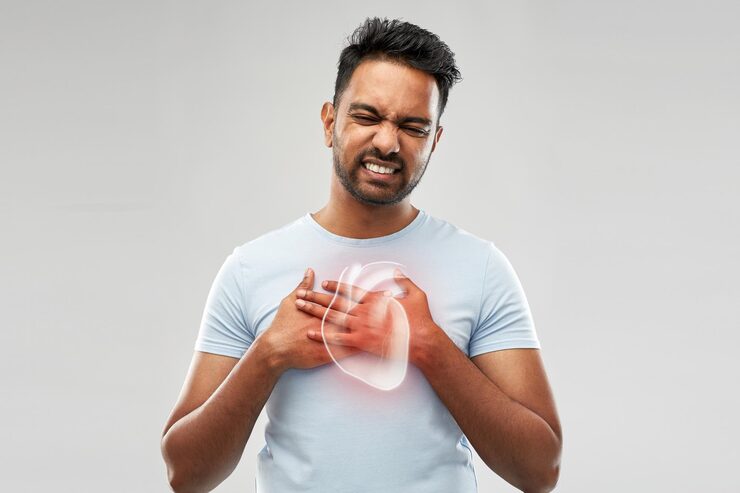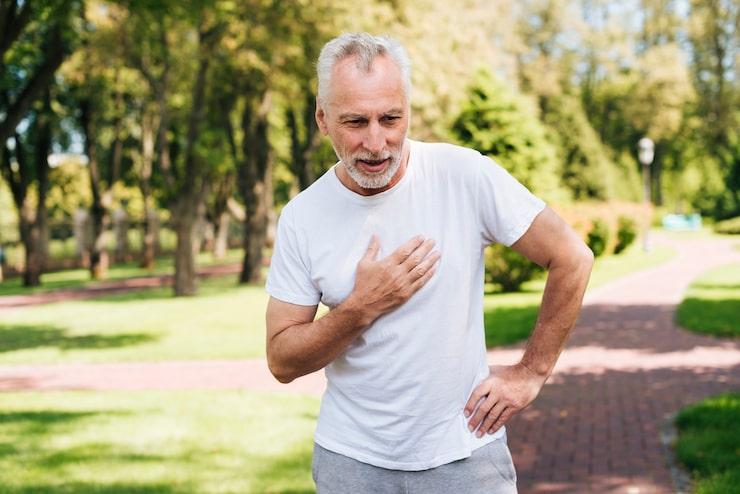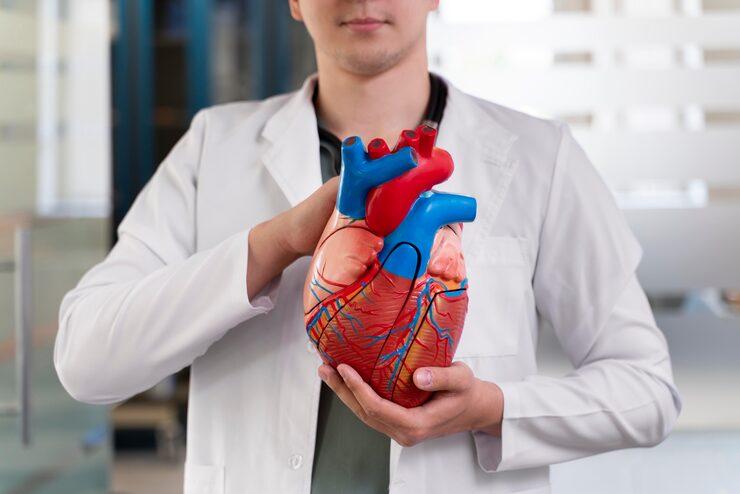
man having a heart attack
A myocardial infarction, or heart attack, is one of the most serious medical crises. It happens when a blood clot blocks blood flow to a portion of the heart muscle. If the heart muscle isn't treated right away, it starts to die, which can cause serious problems or even death.
During a heart attack, every second counts. Being able to recognize the warning signals and know what to do can literally save a life, whether it's yours or someone else's.
Different people may have distinct signs of a heart attack. Some people feel abrupt, acute pain, while others may have indicators that slowly get worse. Some common signs are:

old man having a heart attack
When someone has a heart attack, intervening promptly can be the difference between life and death. Follow these steps:
1. Call for help right away
Call your local emergency number right away. For example, in the U.S., it's 911, and in India, it's 108. If you have no other choice, don't try to drive yourself to the hospital. Paramedics are trained to give medical care on the road and can begin life-saving procedures.
2. Relax and stay calm
Sit down and try to remain as calm as possible. Moving around can place extra stress on the heart, so don't do it.
3. If your doctor says to, chew an aspirin.
If possible, chew and swallow a regular dose of aspirin (typically 325 mg), unless your doctor has instructed you otherwise or you are allergic to it. Aspirin can help thin the blood and may lessen the damage done during a heart attack.
4. If your doctor tells you to, take nitroglycerin.
Take nitroglycerin as indicated if you have chest pain and are waiting for help. Do take someone else's medicine.
5. Take Off or Loosen Tight Clothes: To make it easier to breathe, take off or loosen any tight clothes around your neck or chest.
6. Stay awake and aware
If you feel faint or lose consciousness, try to get the attention of someone nearby. Be ready to initiate CPR (cardiopulmonary resuscitation) if the person you are with has a heart attack and stops responding.
CPR keeps blood circulating to vital organs until help arrives.

doctor holding an anatomical model of a heart
Doctors will rapidly confirm the diagnosis and restore blood flow once you get to the hospital. Some common steps are:
1. Tests right away
An electrocardiogram (ECG) measures the heart's electrical activity.
Blood tests look for enzymes that are generated when cardiac muscle is injured.
2. Treatments for emergencies
Thrombolytics are medications that dissolve blood clots.
Angioplasty and stenting: A catheter is inserted into the blocked artery, and a balloon is inflated to open it up. A stent is then placed to keep it open.
Coronary artery bypass surgery: In severe cases, surgeons create a new path for blood to flow around clogged arteries.
3. Drugs After Treatment
Patients are commonly given drugs to help them avoid having another heart attack. Some of them are blood thinners, such as aspirin and clopidogrel.
Beta-blockers to ease the pressure on the heart
Statins to reduce cholesterol levels
ACE inhibitors to help control blood pressure
Getting through a heart attack starts a new chapter in your life that will involve modifications to your lifestyle and continuing treatment.
1. Cardiac Rehabilitation
Hospitals typically recommend a systematic cardiac rehabilitation program that includes exercise under supervision, nutrition guidance, stress management techniques, and counseling.
2. Changes to Your Way of Life
Eat a variety of fruits, vegetables, lean proteins, and whole grains to maintain a healthy diet. Reduce your intake of sugar, salt, and unhealthy fats.
Stop smoking and drink less alcohol. Both of these things raise your risk of having another heart attack.
Exercise regularly: After receiving clearance from a doctor, engage in moderate physical activity.
Yoga, meditation, and breathing exercises are effective ways to manage stress.
3. Follow-ups regularly
Doctors can keep an eye on recovery, change prescriptions, and lower future risks during routine check-ups.
Not all heart attacks can be avoided, however many risk factors can be controlled. Some ways to stop this from happening are:
1. How can I determine if I have indigestion or a heart attack?
Heartburn gets typically better with antacids and is linked to meals. Pain from a heart attack, on the other hand, is more constant and can spread to other places. Always go to the emergency room if you're not sure.
2. Can persons under 30 suffer heart attacks?
Yes. Heart attacks are more common in elderly people, but they can happen to younger people too because of bad habits, stress, and genetics.
3. How long do I have to wait to get to the hospital during a heart attack?
Right away. The best likelihood of survival and the least damage to the heart happen when treatment starts during the first one to two hours.
4. What is the difference between a heart attack and a cardiac arrest?
A heart attack is when blood flow is impeded, and cardiac arrest is when the heart suddenly stops beating because of an electrical malfunction. A heart attack can sometimes cause the heart to stop beating.
5. What should I do if I think I might be having a heart attack and I'm alone?
Call the police right away. If you can, unlock your door, sit near the entry, and keep your phone close by until help comes.
A heart attack is scary, but knowing what to do in the initial few minutes can save a life. It's essential to understand the indicators, call emergency services right away, and do simple things like relax, take aspirin (if told to), and avoid strenuous activity.
Hospitals have innovative treatments that can help people recover by restoring blood flow, limiting damage, and speeding up the healing process. After a heart attack, many people go on to live healthy, happy lives with the proper care and changes to their lifestyle.
Keep in mind that every minute you waste is a minute of cardiac muscle. Never disregard the indicators that anything is wrong. Taking action quickly can make a big difference.
We offer expert care across key specialties, including Medicine, Cardiology, Orthopaedics, ENT, Gynaecology, and more—delivering trusted treatment under one roof.
Prakash Hospital Pvt. Ltd. is a 100 bedded NABH NABL accredited multispecialty hospital along with a center of trauma and orthopedics. We are in the service of society since 2001.
OUR SPECIALITIES
Contact Us
D – 12A, 12B, Sector-33, G. B. Nagar, Noida, Uttar Pradesh 201301
+91-8826000033

© 2025 All rights reserved.
Designed and Developed by Zarle Infotech